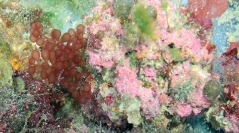

 Cryptogamie, Algologie
35 (1) - Pages 77-98
Cryptogamie, Algologie
35 (1) - Pages 77-98In the northwestern Gulf of Mexico, beds of rhodoliths and unconsolidated rubble at 55-70 m depth are associated with unique offshore deep bank habitats known as salt domes or diapirs. Prior to the 2010 BP Deepwater Horizon oil spill these harbored the highest known seaweed diversity in the northern Gulf of Mexico. Six post-spill cruises led offshore Louisiana to two sites previously documented with rich algal assemblages (i.e. pre-spill) revealed a dramatic post-spill die-off of seaweeds at both sites, with dredged rhodoliths appearing bleached and mostly denuded of fleshy algae, or "bare" (with a few crustose genera only, e.g. Corallinales and Peyssonneliales). This rubble, brought to the laboratory and maintained in a series of ~75 liter microcosm tanks, gradually became covered by a suite of red, green and brown seaweed germlings that to this day continue to grow to adult size, reproduce, disappear and re-emerge, and whose species composition reflects pre-spill assemblages. These experiments revealed the expression of biodiversity from alternative life stages or resting stages apparently repressed in the Gulf at the time of sampling, including new, previously overlooked diversity. The rate of algal succession was documented by biweekly photography, and species taxonomic identity is being confirmed by ongoing molecular and morphological evidence. The implications of these exciting results, namely that undetected propagules, spores and endolithic filaments collected along with the "bare" substrata and in situ seawater have been triggered to germinate, grow, and reproduce under laboratory conditions are far-reaching. We hypothesize the function of rhodoliths and rubble as marine seedbanks for biological diversity and explore the role of this ecosystem for community resilience following a major anthropogenic disaster. This is a speculative paper since we currently lack many rigorous, quantitative data. The paper is envisioned as a "first step" in approaching the dynamics of rhodoliths and associated diversity following a catastrophic anthropogenic event, from which the algal and invertebrate diversity has not recovered, as of October 2013, our last collecting expedition to Ewing Bank in the NW Gulf of Mexico.